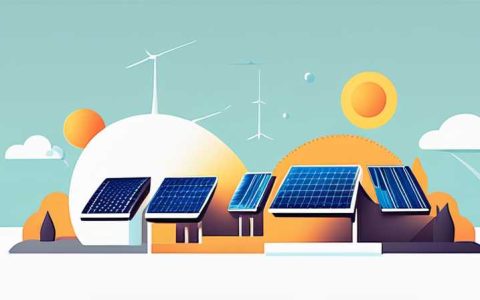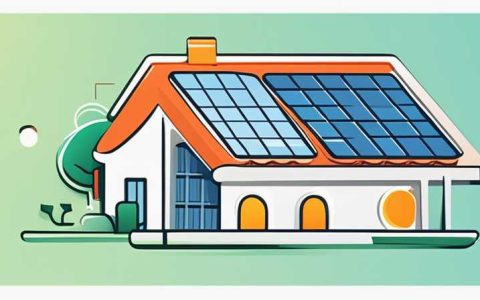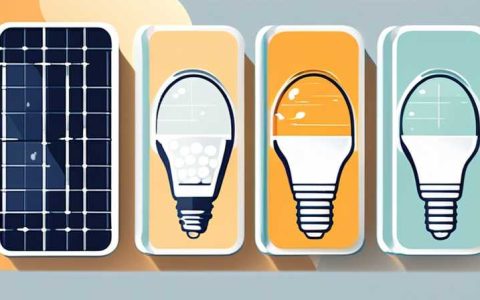
Installing solar lights without electricity is a cost-effective and environmentally friendly way to brighten outdoor spaces. 1. Solar lights operate independently from the grid, harnessing the sun’s energy to power illumination, 2. Without electrical installation, the process is simpler and safer, reducing the complexity of wiring and electrical safety, 3. Self-sustaining energy sources like solar lights contribute to sustainability and energy independence. By utilizing solar lights, homeowners can enhance their landscape while lowering carbon footprints and utility costs.
1. UNDERSTANDING SOLAR LIGHTS
Solar lighting systems harness the natural energy emitted by the sun. Unlike traditional electric lights, these fixtures rely on solar panels to absorb sunlight during the day, effectively converting this energy into electricity. This electricity is stored in batteries, enabling lights to function during the night. Solar lights come in various types, from path lights to floodlights, catering to diverse needs and aesthetic preferences.
Exploring the design of solar lights reveals how they are engineered for efficiency and longevity. Each solar light comprises key components: solar panels, rechargeable batteries, LEDs, and a control system. The solar panel collects solar energy throughout the day, while the batteries store this energy for nighttime use. LEDs are chosen for their energy-efficient properties, consuming minimal power while providing ample illumination. This design is crucial for sustainability and accessibility, catering to homeowners concerned about environmental impact.
2. PREPARING FOR INSTALLATION
To successfully install solar lights without electricity, careful preparation is essential. Selecting the right location is fundamental. The ideal placement involves assessing areas with maximum exposure to sunlight. Inspecting surrounding obstructions such as trees, buildings, or fences will ensure solar panels receive adequate sunlight without interference. Often, south-facing areas of a yard receive the most sun, providing optimal energy capture for solar lights.
In addition to location, understanding local environmental conditions can significantly influence performance. Weather conditions such as prolonged rain or shade can affect charging efficiency. Homeowners should evaluate seasonal sunlight patterns, choosing spots that remain sunny for extended periods. For instance, in winter, if large snow piles develop, they may block sunlight from reaching panels, which can adversely affect performance. Therefore, meticulous planning leads to a successful solar lighting setup.
3. GATHERING NECESSARY MATERIALS
Once an ideal location is determined, gathering the required materials for the installation becomes paramount. Typically, solar lights come packaged with essential components. However, there are additional tools needed for an effective setup. These include a shovel for digging holes, a level to ensure proper alignment, and a tape measure to ascertain distances between lights.
Checking the specifications provided by manufacturers is vital for ensuring quality installation. Understanding the parameters detailed in the packaging—such as battery capacity and lumens produced—provides insight into performance expectations. When selecting solar lights, opting for fixtures with higher lumens is often advisable for bright pathways or areas with high foot traffic. Enhanced knowledge of technical specifications will facilitate informed decisions, optimizing energy use and brightness.
4. INSTALLATION TECHNIQUES
The act of installing solar lights requires following prescribed techniques to ensure functionality. Begin by determining the appropriate depth for any embedded lights. As a general rule, digging holes approximately six inches deep provides a sturdy foundation for the fixture without interference from surface roots or rocks. The holes should also accommodate wiring, if applicable.
After positioning the lights, the next step involves inserting the solar panel unit into the ground. Most solar lights feature staked designs for easy installation. For additional stability, homeowners may consider using concrete or cement to secure the base further. Ensuring proper sunlight exposure hinges on adjusting the angle of the solar panel, allowing it to capture direct sunlight. This optimization plays a significant role in maximizing energy efficiency.
5. MAINTENANCE OF SOLAR LIGHTS
To prolong the lifespan and efficiency of solar lights, regular maintenance is crucial. Cleaning the solar panels periodically ensures optimum energy capture. Dust, leaves, or other debris can impede solar absorption, directly affecting lighting performance. A soft cloth and water should suffice for routine cleaning, avoiding abrasive materials that might scratch the panels.
Another maintenance step includes checking the battery health routinely. Over time, batteries may degrade, affecting performance and runtime. Most solar light batteries last between two to four years, depending on usage and environmental conditions. Replacing them when necessary significantly extends the overall life of the solar lighting system, ensuring continued functionality and reliability.
6. COMMON ERRORS TO AVOID
While installing solar lights seems straightforward, some common pitfalls should be avoided. One major mistake is placing lights in shaded areas. Such positioning hampers performance, limiting absorption of sunlight necessary for efficient operation. Areas blocked by buildings or trees should be assessed critically before installation.
Occasionally, homeowners might ignore the importance of the surrounding landscape. Failure to consider environmental changes such as tree growth or developing structures can lead to diminished solar light functionality over time. Staying vigilant about potential obstructions will minimize future issues. By assessing the surroundings periodically, preparations can be made to adjust the lights, ensuring they continue to operate efficiently.
7. SOLAR LIGHTS AND ENVIRONMENTAL IMPACT
Adopting solar lights not only enhances outdoor illumination but also contributes positively to the environment. Solar lights utilize renewable energy, which reduces dependency on fossil fuels. As societies become increasingly aware of climatic issues, making sustainable choices is essential in minimizing carbon footprints.
Moreover, the use of solar lights helps decrease electricity consumption during peak hours, alleviating pressure on electrical grids. This shift not only promotes energy independence but also supports a transition to greener energy practices. Advocating and adopting solar technologies is key in paving the way for innovative solutions that reduce waste while promoting eco-friendly practices.
8. ECONOMIC BENEFITS OF SOLAR LIGHTING
Investing in solar lights presents multiple economic advantages. Although the initial outlay for solar lighting installations may appear higher than traditional lighting systems, substantial savings can occur over time. Homeowners enjoy reduced electric bills due to less reliance on grid power. Additionally, there are minimal operational costs associated with solar lighting—there’s no need for ongoing electrical maintenance or service, further enhancing financial benefits.
Furthermore, many local governments are instituting rebate programs or tax incentives for adopting renewable energy practices. Engaging in these programs can yield considerable financial returns, offsetting installation costs and encouraging broader community participation in green initiatives. Embracing a solar lighting system not only enhances property curb appeal but also supports homeowner investment sustainability and environmental stewardship.
9. ENHANCING AESTHETICS WITH SOLAR LIGHTS
Beyond their functional benefits, solar lights serve a decorative role in landscaping and outdoor design. Choosing various styles, colors, and designs contributes to enhanced home aesthetics. Solar fixtures can accentuate gardens, pathways, and architectural features, creating inviting environments for residents and guests alike.
Utilizing smart lighting options equipped with programmable features or color-changing capabilities can further elevate visual appeal. Such innovations, paired with traditional solar lights, allow homeowners to create tailored moods and atmospheres. Moreover, employing different styles of solar lights can delineate distinct areas within an outdoor space, establishing elegant transitions between walkways and resting spots, combining form with function.
FAQs
WHAT TYPES OF SOLAR LIGHTS ARE AVAILABLE FOR INSTALLATION?
A diverse array of solar lights is available, catering to varied applications, aesthetic preferences, and environmental conditions. Common types include path lights, spotlight fixtures, wall-mounted lamps, and decorative string lights. Each type serves different purposes, from enhancing safety along pathways to providing ambient lighting on patios. Path lights generally illuminate walkways, ensuring safe passage after sundown. They are usually low to the ground with soft illumination, creating an inviting environment. Spotlight fixtures, on the other hand, focus on highlighting specific features such as trees, architectural elements or garden accents. Each type contributes to outdoor design objectives, addressing both functional and artistic needs.
HOW LONG DO SOLAR LIGHTS LAST, AND WHAT IS THEIR LIFESPAN?
Solar lights generally provide notable service life but vary widely based on materials used, quality, and maintenance. High-quality solar lights typically last between two to five years, depending on environmental conditions and battery types. LED components, which are prevalent in solar fixtures, boast impressive longevity, often lasting over 25,000 hours. In addition to LED life spans, the rechargeable batteries usually last approximately two to four years before requiring replacement. Proper maintenance, such as cleaning panels and replacing batteries when needed, significantly extends the overall lifespan and functionality of solar lights.
CAN SOLAR LIGHTS BE USED IN SHADY AREAS?
Solar lights can technically function in shady spots; however, their performance will likely diminish significantly. Insufficient direct sunlight results in inadequate energy capture, leading to reduced brightness and shorter operating times. Homeowners should assess areas for potential obstructions, including trees, buildings, and fences that may cast shadows. If shaded placement is unavoidable, considering lights with a larger solar panel area or the option of installing fixtures with external battery packs may enhance performance. Alternatively, strategically trimming overgrown vegetation or implementing reflective surfaces in the landscape can improve sunlight access, thereby supporting the effectiveness of solar lighting.
In summary, effective installation of solar lights without reliance on electric grids is entirely achievable, promoting both sustainability and aesthetic beauty. This method simplifies outdoor lighting while fostering energy independence and reducing carbon footprints. Supportive research and planning ensure reliable, efficient, and visually pleasing lighting outcomes, which ultimately enhance outdoor spaces.
Original article by NenPower, If reposted, please credit the source: https://nenpower.com/blog/how-to-install-solar-lights-without-electricity/









